Creature Comforts: A Review of "Lilo and Stitch" (2025)
The new "Lilo and Stitch" successfully surfs the waves of millennial nostalgia, in yet another live action remake of an animated classic.
Let me get this out of the way, the live action Lilo and Stitch is not a good movie. At best, it’s a decent attempt at the imitation of what a good movie looks like, i.e. the original Lilo and Stitch, and it’s a testament to that movie’s storytelling (particularly the underrated dynamic duo Chris Sanders and Dean DeBlois) that the emotional core remains clear, even after being faded by the Walt Disney company’s animation-to-live-action copying machine
To be honest, I questioned whether to even bother writing this review. I’d already aired most of my grievances back in my review of Snow White, but after seeing it myself, and how successful it’s become, I decided it was worth returning to the live action wishing well.
Because despite sharing most of the same problems these live action remakes have always run into, audiences showed up to see Stitch in big numbers over Memorial Day weekend, instantly outgrossing Snow White’s entire run. So, what’s the difference? Why have audiences responded so well to this movie, where before they seemed indifferent, if not completely over these kinds of retreads? I figured reviewing it might reveal that answer, because the more I thought about it, the more I realized these two films represent the two sides of how these remakes can turn out.
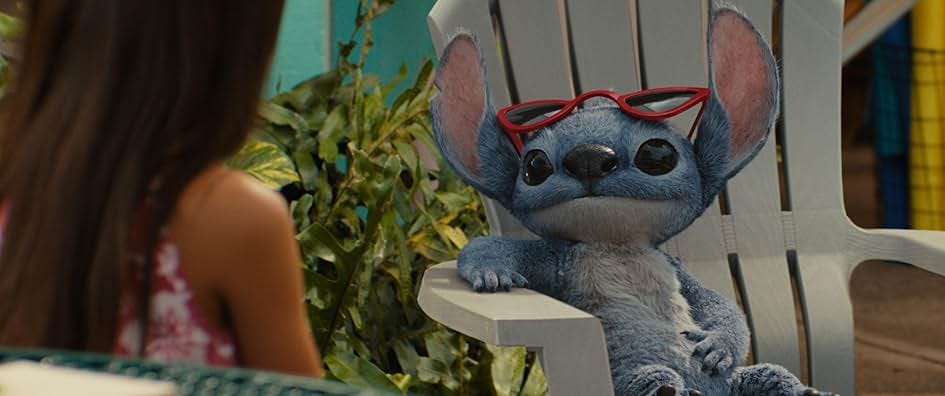
An instant dread came over me when the movie opened on an almost shot-for-shot recreation of the 2002 film’s opening. Criminal mad scientist, Jumba, along with his deadly creation Experiment 626 (that’s Stitch) on trial. I’m not kidding when I say that it’s 95% the same shots, dialogue, even sound effects, that they might as well have just spliced in the opening from the first movie. At least then I could have enjoyed the pleasant color palette and fluid hand drawn images. Just like virtually every other live action production from the House of Mouse, the CGI is rendered in a dark, overly shiny, sometimes overly muddy way that always looks wrong. It’s like these designs weren’t originally meant for this format or something.
As a result of ILM’s “realistic” CGI, Chris Sander’s once charming alien designs come off as cartoonish in a way that doesn’t fit the rest of the movie. The juxtaposition between science fiction and grounded human story was a tricky tightrope walk that even the animated film didn’t always balance perfectly. Here, that problem is multiplied ten-fold. In the original, the animation assured there was at least a visual consistency to fall back on, but here, whenever things switch over to the alien side of the story, it feels like we’ve entered an entirely different movie. As a result, even when the film does look good, mostly when it’s showing off the shot-on-location Hawaiian parts, it never fully gels.
The one special effect that does work, thankfully, is Stitch himself. He’s just as fluffy, cute, and endlessly marketable as ever. Look, I’m not hating, I have a few pieces of Stitch merchandise myself that I’ve collected over the years. That’s one of the reasons why this movie got made in the first place. Getting the Stitch character right wasn’t just necessary for the movie, but for all the merchandise Disney wants to sell as part of their endless brand synergy. One positive result of this cynical strategy is that the CG Stitch clearly got top priority over everything else.
The reason Stitch works better than most other 2D to 3D characters isn’t just image quality, but also because he’s more fully implemented into the live-action parts of the movie than, say, the dwarfs in Snow White.
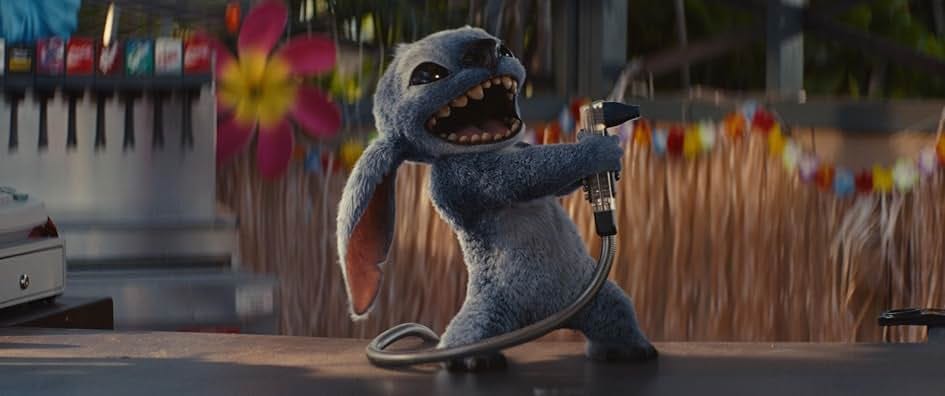
Allow me to explain — this is something too many filmmakers forget when it comes to implementing CG characters. Think about memorable characters who are also special effects, like Roger Rabbit or Gollum – when you think about their best scenes, it’s usually when they’re sharing the screen with live actors. One of the best moments in any movie ever (in my opinion) is when Roger Rabbit dances in the bar and he’s kicking real plates off the table while Eddie Valiant grabs him. One of the most intense moments in The Lord of the Rings series is when Gollum jumps on Frodo trying to wrestle the ring away from him. In both cases they’re not dancing off to the side in a void, they’re physically acting with their co-stars. If you want an audience to believe in these kinds of effects, then you’ve gotta bump the lamp every so often.
Which is why, alongside the fine folks at ILM, it’s Lilo herself who deserves credit for making Stitch as believable as he is. Played by newcomer Maia Kealoha, she’s being asked to do a lot of the heavy lifting in this movie, and most of it alongside a co-lead who isn’t even there. She pulls it off though, and she successfully taps into the original Lilo’s personality while giving it her own unique spin. Her take has less of the anti-social tendencies of the original and leans towards a more mischievous streak. The montage of her and Stitch bonding while engaging in all matter of hijinks around a Hawaiian resort is where I first noticed the movie’s charm starting to work on me.
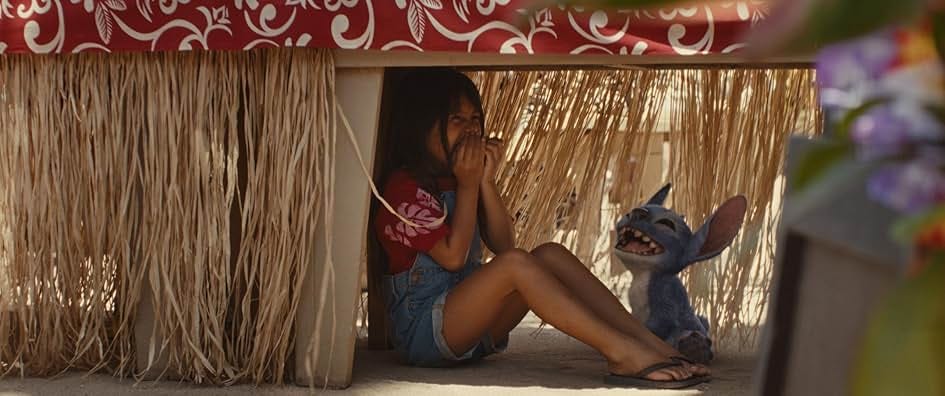
As for the rest of the cast, Chris Sanders is back as the voice of Stitch, and a few of the other past voice actors from both the original movie and TV show get little cameo roles here and there as a bone thrown to the fans. I’ll admit, it’s nice to see them get some acknowledgement.
Sydney Elizebeth Agudong takes over the role of Nani, and her sisterly chemistry with Maia feels authentic. There have been a few questionable changes made to Nani, and we’ll get into that, but as far as her performance goes, I really liked her. When she sings to Lilo in the famous hammock scene to comfort her and promise they will always be together no matter how far apart they might be, I’ll admit it, I teared up just a little bit. As I’ve said in the past, sibling drama always hits me hard.
The rest of the cast is mostly solid, but the biggest blemish, I’m sorry to report, is Zach Galifianakis as Jumba, whom he both voices as an alien and then plays in live action while in his human form. In either version his performance fell flat for me, and it’s not just because they decided to get rid of his goofy Eastern European accent. It never feels like Zach Galifianakis ever has a clear handle on what kind of performance he’s going for. At times he plays it as a goof, and other times as an amoral scientist, but he never hits that sweet spot of the goofy amoral scientist ala Jim Carrey in the Sonic movies. At least I think that’s what he’s trying to go for.
In his defense, the movie itself never seems to have a handle on Jumba’s character either. In the original he was an outcast like Stitch and Lilo, which is what eventually won him over to their side. Now he’s the main villain, and more akin to an abusive parent. This isn’t necessarily a terrible twist, but you can’t completely change a character and the have them to be able to repeat bits from the last movie like they’re the same person (er, alien).
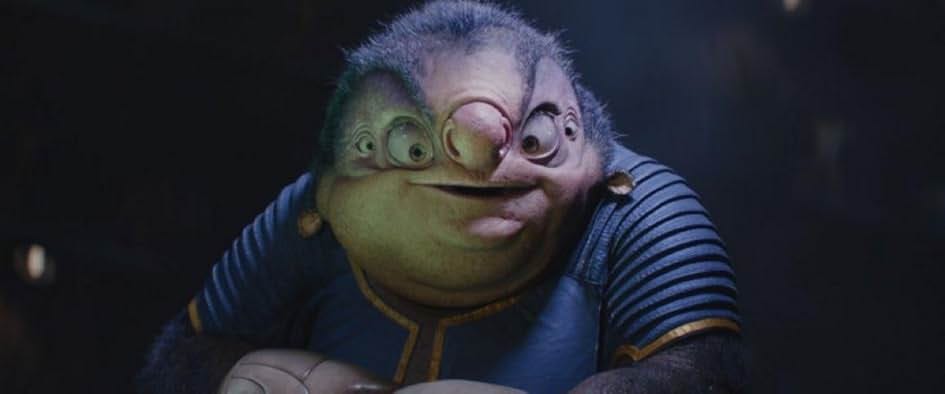
I would like to give a special shoutout to Billy Magnussen, who does a very good take on Pleakly. He sadly doesn’t get to dress in drag, and the script goes to a lot of trouble to reassure audience his immediate attraction to Jumba is purely platonic, though I get the feeling Magnussen may have had other ideas. To be clear, this is all conjecture on my part, but I can see the potential for some great buddy comedy, unfortunately, I suspect, Disney Studio heads are too afraid of possibly offending some part of the mythical four quadrant audience to try anything as daring as his performance would suggest.
Not that the animated version was pushing the boundaries of children’s entertainment, but for a Disney movie, yeah, having Pleakly, a male coded alien, enjoy wearing dresses and a wig felt a bit daring. Here was a mainstream kids movie with two women of color as co-leads, alongside a violent alien. Lilo especially was unlike any other child character in a Disney animated movie: troubled, hyperactive, and even sometimes mean. Disney was already softening the movie when it edited out a dryer Lilo hides from Nani in with a dryer sized pizza box (???) in later releases of the film.
Those elements are still present – technically – but it feels like those edges that made the original unique amongst the Disney Animated catalog have been filed down. One thing I took special notice of was a change made to one of the original film’s running gags, where a sunburnt tourist gets his ice cream ruined multiple times. The tourist has been replaced with a native Hawaiian actor. Why? I suspect it’s because Disney Hawaiian Resorts doesn’t want to let any potential customers feel like they’re being made the butt of a joke. Rest assured, dear viewer, your Disney brand ice cream will be secure.
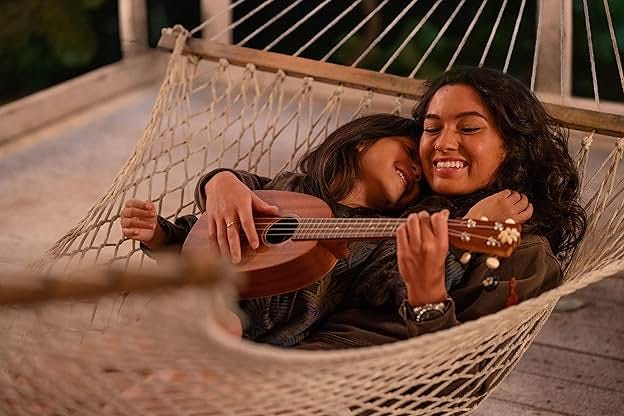
More overt changes: the original social worker, Cobra Bubbles, originally played by a menacing Ving Rhames, has been replaced by a kinder, gentler one played by Tia Carrera (also the original voice of Nani). It’s further evidence of Disney’s fear of making their audiences feel any negative emotions. Ironically though, she comes off as even more menacing when at the hospital while Lilo is getting checked out after almost drowning, she tells Nani that social services will pay for all of it if she gives Lilo up for adoption. There’s a new subplot about Nani having to sign her and Lilo up for health insurance. That almost feels like it’s trying to say something, but any intent the filmmakers may have had as, once again, been smoothed out to try and avoid having this movie, which is about how government bureaucracy punishes the poor and those who need their services, being about anything.
Another major change is that Nani no longer remains Lilo’s guardian at the end. Instead, she lets her be adopted by their neighbors so she can go to San Diego and fulfill her dream of studying marine biology. I’ve seen a lot of people online criticize this as going against the film’s theme of ohana, pointing out that government services pressuring native people into giving up their children and culture to conform to more mainstream (re: Caucasian/white) ideas is a serious issue.
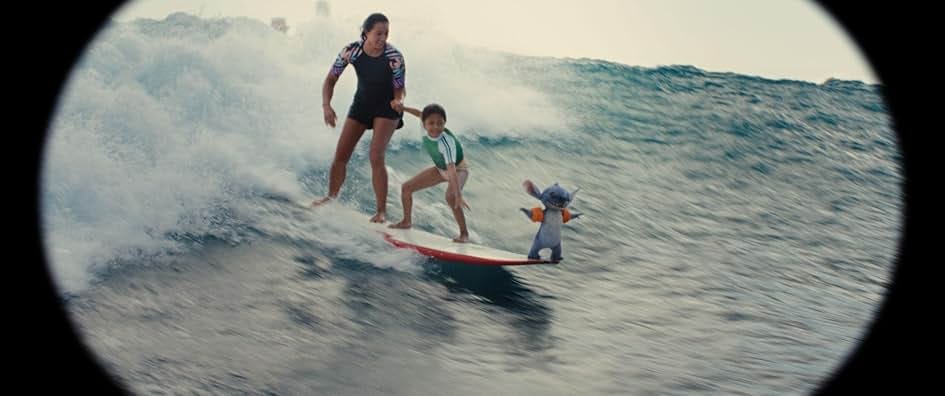
I think they make a good point. I will defend the choice from the perspective that, as the movie tells us, ohana means, family, and family means nobody gets left behind, and that should include yourself. If Nani’s dream is to study, then as her ohana Lilo and her neighbors would want to support that. The fact that it’s an indigenous Hawaiian family close to Lilo and Nani that are the adopters should also be acknowledged.
With that said, I also don’t think its handled as well as it could have been. Nani’s alleged love for science never comes into play during the story. The only reason we even know she has an interest is because we’re told by other characters giving clumsy exposition several times. The only thing she cares outside her sister that we see evidence of is surfing. Wouldn’t it make more sense if she wanted to be a professional surfer then? Instead, the movie gives her both.
Her neighbors: love interest David and his mom, we are told, are all part of Nani’s ohana because of a past connection between their families, but we never see or really hear about any of that. We see them interact with Nani, but the movie doesn’t develop either of those character’s relationship with Lilo in a way that makes it feel like the adoption at the end is paying anything off. Again, it’s like two different screenplays for the same movie are fighting for dominance, as a result, the new plot elements feel awkwardly shoehorned.
Even as I am writing this review Lilo and Stitch has already made back triple its budget and is looking to continue to clean up. I predicted as much back in March (allow me to pat myself on the back this one time, I promise I’ll make a bad call again soon) and that means no lessons will be learned from Snow White and the Mickey eared ouroboros will keep on trucking along.
Look, if you really want to know my opinion, it’s fine. This is the very definition of a 2.5 out of 5-star rating on Letterboxd. Little kids who either haven’t seen the animated version, or have seen it too many times, will enjoy it, while their millennial parents – along with childless millennials (Hello there!) – will get a good enough nostalgia high to leave the theatre satisfied. Still, I can’t help but feel bad that kids nowadays must live off the scraps of their elders, rather than getting to experience their own stories, like mine did when we were first introduced to Stitch and his ohana. I can’t lie, it was nice revisiting my old friend, Stitch. But he, Lilo, and Nani deserve more effort than this.


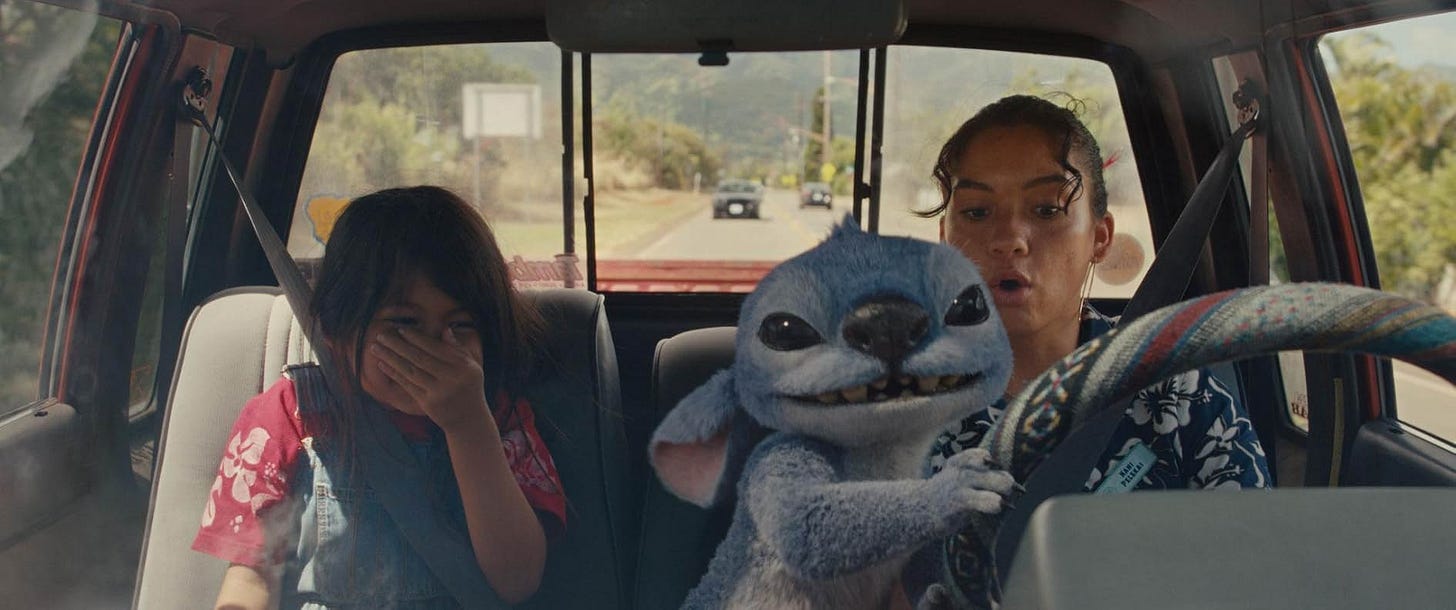
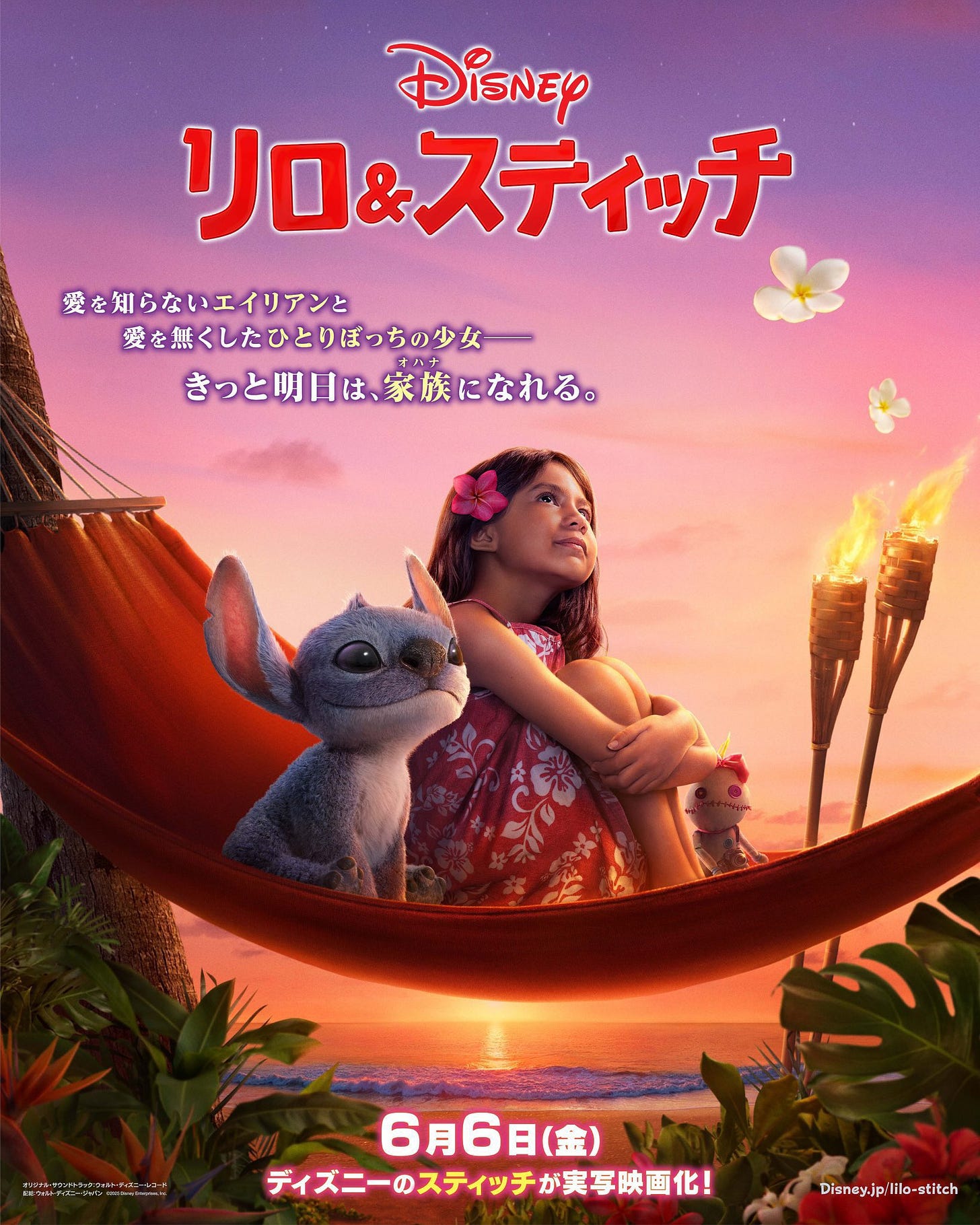
Haha. Love that you don't bury the lede!